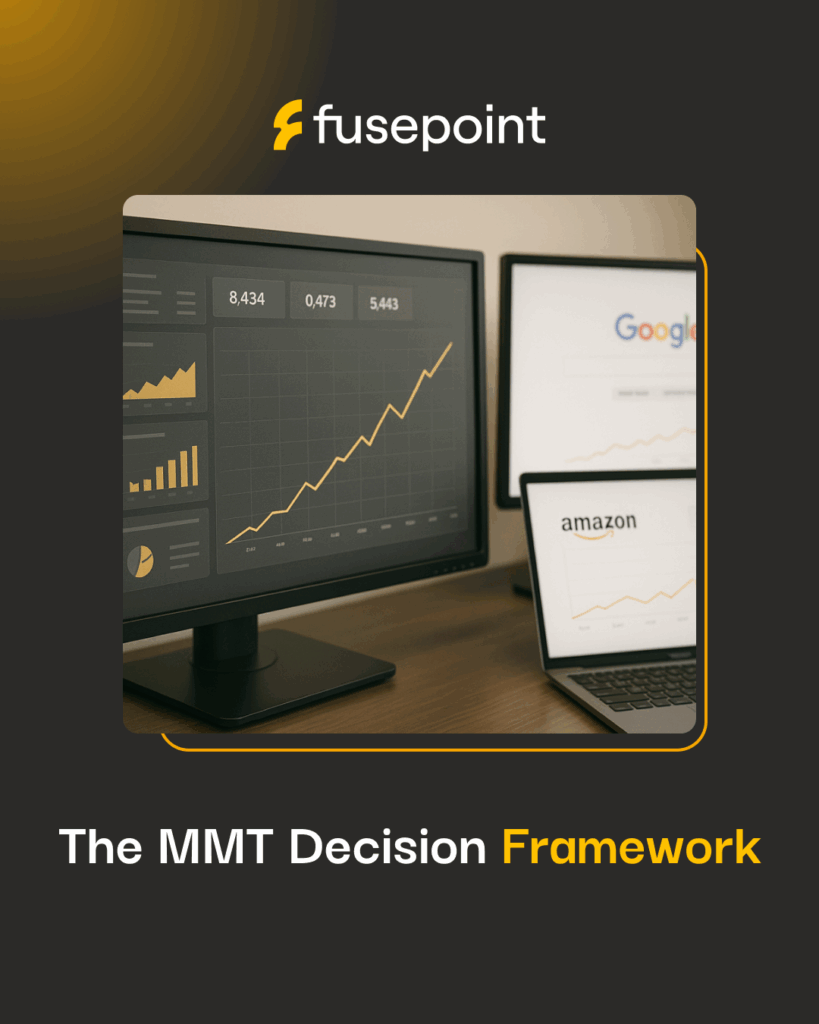How to Create a Media Plan That Actually Drives ROI

- 1. What is media planning?
- 2. How to create a media plan: 5 steps for designing one that actually works
- 3. Common pitfalls in media planning (and how to avoid them)
- 4. ROI frameworks for smarter media plans
- 5. Case study callout: Healthcare apparel
- 6. Tools vs strategy: Why human-led frameworks outperform software-only solutions
- 7. Sharpen and strengthen your media plan with fusepoint
For all the budget poured into media planning, many businesses still struggle to demonstrate the impact of their campaigns on their profitability. All too often, media plans are built solely around impressions, reach, or channel trends rather than the patterns and metrics that actually propel a business forward.
The underlying issue here is that many marketers get distracted by vanity metrics and half-baked measurement frameworks. While these can look glossy in a deck, they contribute to inter-team misalignment and, as finance teams will tell you, discourage bottom lines.1
What’s the solution? Media plans that are specifically designed to drive ROI, from start to finish. By reframing media planning around business outcomes rather than short-term gains, senior marketers can prevent mispending while advancing visibility and profit in tandem.
What is media planning?
At its most fundamental, media planning is the process of determining where, when, and how to deliver brand messaging so that it reaches the intended audience efficiently. Most definitions stop there—but there’s a big difference between a textbook media plan and one that performs well.2
Effective media plans don’t simply allocate budget across channels. They start by outlining goals related to:
-
What business outcomes the brand expects
-
How success will be tracked and measured
-
How much ROI is required
All of these are projected measurements. While generic media plans are typically channel-first (e.g. “We’ll spend 30% on social, 20% on search”), effective ones lead with ROI (“We need a 4:1 return on ad spend—here’s how each channel will contribute to that outcome”).
Making ROI the starting point helps prevent campaigns from drifting toward activities that might look good on paper, but don’t move the needle. Setting ROI expectations up front forces alignment: You know how much revenue you expect from a campaign, how much budget is justified, and which channels are historically proven to deliver.
This puts profitability—rather than surface-level metrics—front and center.
How to create a media plan: 5 steps for designing one that actually works
Ultimately, the recipe for an ineffective media plan is putting marketing activities before financial outcomes. Alternatively, robust media plans treat ROI as the organizing principle. What does this look like in practice?
-
Defining business goals and ROI targets – First, media plans must be designed around what a given campaign is supposed to achieve. Are you looking to net new customers? Improve your margins through better retention? Clearly defining your objective is a must for setting explicit targets later.
-
Conducting audience and market research – Audience research helps ensure media plans jive with real-world buying behavior. Too many campaigns deflate their returns by trying to capture audiences too broadly, or missing real-world nuances like media scrolling habits and purchase triggers. Partnering with experts who offer customer research services can help uncover the nuances your plan needs to win.
-
Selecting channels and allocating budget – Channel selection should stem directly from these first two steps: ROI modeling and audience insights gained through research. The goal here isn’t ubiquity—being everywhere your customer is—but rather efficiency: You want to appear where your target audience is most likely to convert, at a cost that’s sustainable for your business.
-
Aligning messaging and creative – Even an on-target channel mix fails if the creative is misattuned. Your messaging hierarchy must align with both the channel environment and the stage your buyer is in their journey, all while staying grounded in the goals you set out to achieve in step 1.
-
Building and testing a measurement framework – It’s imperative to build a funnel measurement framework that blends the micro (surface metrics) and macro (business objectives). Both of these factor into ROI.
For this, controlled assessments like incrementality testing can be a game-changer3. These tests help you differentiate between the lift you can chalk up to media placements, as opposed to your baseline performance. The data they acquire, when paired with marketing mix modeling helps sharpen your strategy for the next media plan you have in the works.
Common pitfalls in media planning (and how to avoid them)
Even experienced marketers can fall into common traps when crafting a media plan. Unfortunately, this usually means wasted spend, misleading metrics, or a DOA campaign.
To avoid these outcomes, watch out for the following pitfalls:
-
Chasing impressions – In some cases, marketers might report millions of impressions, but revenue still flatlines. Often, this means media KPIs are tethered to vanity metrics rather than actual margin contribution4. From a financial perspective, visibility means little if it isn’t followed up by action.
-
Channel fragmentation – Too often, media buyers and planners chase ubiquity by placing ads across too many channels, resulting in a fragmented approach. Not only is this unmanageable, but it also typically results in diluted spending. Media plans generally fare better when they focus on high-performing channels that are already proven to be profitable. You can always experiment with your mix and spend later, once you’re on solid footing.
-
Correlation vs. causation – In some cases, sales spike after a campaign, and stakeholders assume the campaign caused it—but this isn’t always the case. Using incrementality experiments can help keep marketers from conflating correlation and causation. This way, you’ll differentiate between maneuvers that were actually impactful, as opposed to merely coincidental.
-
Making creative an afterthought – Marketers can be prone to vexing over their media blueprints for weeks and months, and then cramming in creative at the penultimate moment. However, creative development and planning must work in tandem. Creative designed without channels and context in mind is susceptible to falling on deaf ears. Bringing planning, buying, and creative teams together early and regularly is a smart way to ensure messaging will register with audiences.
ROI frameworks for smarter media plans
Sophisticated digital media planning and buying requires frameworks that investigate how—not just whether—campaigns drive meaningful growth.
Two areas are especially ripe for consideration from senior marketers:
-
Incrementality vs. correlation – One of the biggest hurdles in measurement is proving that ads caused an outcome, not just co-arose with it. Sales can rise for any number of reasons, from seasonality to market competition dynamics. Incrementality testing methods like A/B and geo testing (holdout testing or growth testing) help discern whether media placements actually drove additional revenue or simply coincided with it. This information enables brands to allocate budget with far more confidence5.
-
Short-term wins vs. long-term lift — Immediate hits vs. delayed gratification is a major issue in modern media, but it’s also a major theme for businesses. In media planning, it’s common to over-optimize for short-term performance. Some campaigns exhibit robust ROAS in their first few weeks, but wind up starving demand long-term.
On the other hand, some brand-building campaigns can appear ineffective in the short run, but contribute to significant long-term lift. Effective ROI frameworks balance both, yielding immediate wins while building lasting momentum for brands.
Case study callout: Healthcare apparel
The reality is that human behavior is the decisive factor in media planning. This might strike senior marketers as obvious, but it’s all too often ignored in practice (especially with multiple teams involved).
Let’s explore a healthcare digital marketing case study: A holding company came to fusepoint to boost profitability across a family of healthcare apparel brands. While step 1, objective-setting, had been cemented (augment profits), step 2 had fallen short.
The fusepoint team dedicated efforts to researching and segmenting audiences for each sub-brand. The team investigated who the highest-value buyers were and how they could best be reached in context through personalized campaigns.
The newly research-informed media plan brought targeted results:
-
30% uptick in average order value
-
80% lift in revenue
-
$1.3M profit growth YoY
The kicker? The business spent the exact same amount on media distribution—only this time, the fusepoint team had cut the fat with an applied, research-honed strategy.
Tools vs strategy: Why human-led frameworks outperform software-only solutions
This case study brings up another key point: Automation is a helpful accelerant, but it can’t replace humanity in marketing.
Marketers who rely solely on software run the risk of missing key observations and optimizing for the wrong goals. In other words, automating your media planning will only be as sharp as your inputs: While software excels at optimizing within set parameters, it can’t consistently set appropriate strategic objectives or weigh trade-offs in a business context.
Human-led approaches are better at:
-
Deliberating on and defining ROI objectives
-
Using software as an execution engine, rather than a substitute for strategy
When you lead with people—as fusepoint did in the case study above—media planning frameworks have a better chance of staying rooted in profitability, not just algorithmic efficiency.
Sharpen and strengthen your media plan with fusepoint
If your media blueprints aren’t delivering, partnering with fusepoint can help you diagnose the problem. Our team uses historical data, as well as new research initiatives, to make sense of your media wins and losses and close buying gaps that may not have been on your radar.
When waste is legible in bungled campaigns, marketing becomes an extension of finance. That’s how we function in every case: building frameworks that’ll maximize returns on every dollar you plan to spend.
Discover how this approach can elevate your next campaign by connecting with a measurement expert to explore our media planning services today.
Sources
Semrush. How to Create a Media Plan in 10 Steps. https://www.semrush.com/blog/media-planning/
Think with Google. Incrementality testing: The key to unlocking profitable growth in a changing industry. https://business.google.com/us/think/measurement/incrementality-testing/
Entrepreneur. How to Tell If Your Marketing Is Driving Real Business Results. https://www.entrepreneur.com/growing-a-business/not-sure-if-your-marketing-is-working-start-with-these/492750
Lifesight. Geo Experiments in Marketing: A Guide for Testing and Measurement. https://lifesight.io/blog/geo-experiments-guide/
______________________________
1 Entrepreneur. How to Tell If Your Marketing Is Driving Real Business Results. https://www.entrepreneur.com/growing-a-business/not-sure-if-your-marketing-is-working-start-with-these/492750.
2 Semrush. How to Create a Media Plan in 10 Steps. https://www.semrush.com/blog/media-planning/.
3 Think with Google. Incrementality testing: The key to unlocking profitable growth in a changing industry. https://business.google.com/us/think/measurement/incrementality-testing/
4 Entrepreneur. How to Tell If Your Marketing Is Driving Real Business Results. https://www.entrepreneur.com/growing-a-business/not-sure-if-your-marketing-is-working-start-with-these/492750
5 lifesight. Geo Experiments in Marketing: A Guide for Testingfruitless and Measurement. https://lifesight.io/blog/geo-experiments-guide/
Our Editorial Standards
Reviewed for Accuracy
Every piece is fact-checked for precision.
Up-to-Date Research
We reflect the latest trends and insights.
Credible References
Backed by trusted industry sources.
Actionable & Insight-Driven
Strategic takeaways for real results.








